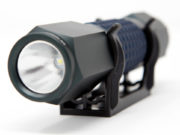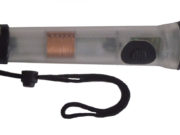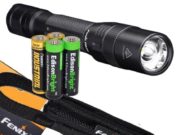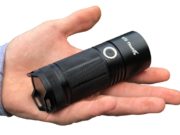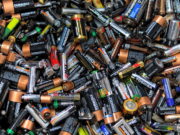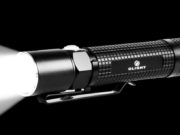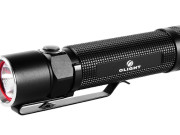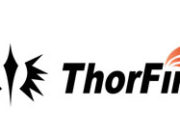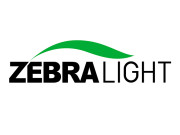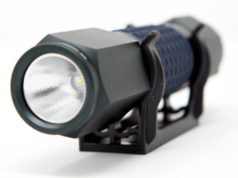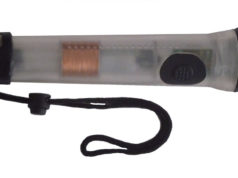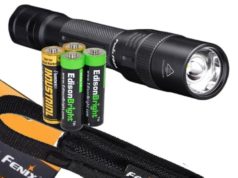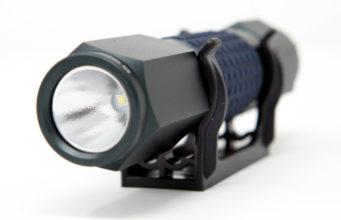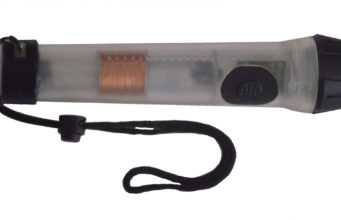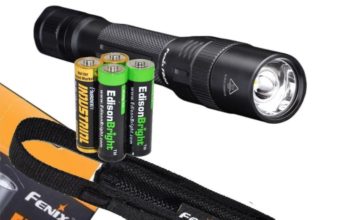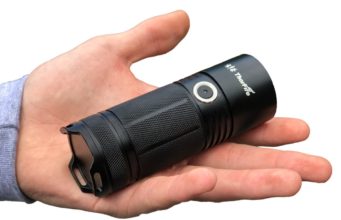Someday, a flashlight might just save your life.
Yes, we’re obviously big fans of flashlights here at Best Flashlight Report, but even we don’t think that’s an exaggeration. At some point, having a flashlight in your pocket or purse could conceivably save your life.
There are the obvious examples of when you might need light in a pinch: a sudden power outage, perhaps, or when your car gets a flat on a dark, country lane. Life is much easier when you can see what you’re doing.
But what about a situation where someone wants to do you harm? To rob you, or beat you up, or worse? If this happens in the dark – and the majority of such attacks do happen at night – having a flashlight can help you prevent the situation entirely or minimise its effects. In short, knowing how to use a flashlight for self defense can be a great way to get out of a tight spot.
There are three main ways that a flashlight can help you, and we’ll run through all of them in detail. In summary, though, they are:
- Help you identify potential threats and avoid them;
- Disorient an attacker and let you escape or launch a counter-attack;
- Act as an improvised weapon if you can’t avoid conflict.
Before we go any further, let’s make one thing very clear. The best option in any type of hazardous situation is to minimise harm. If you can escape (and thanks to your flashlight, you’ll hopefully have that option), then you should. Don’t put yourself in harm’s way if you’ve any way out. Just because you have a flashlight, it doesn’t mean you’re Superman.
Identify threats
This is the first line of defence, and simply comes down to a greater awareness of what’s happening around you.
If you’re walking down a dark street at night, simply having a flashlight and shining it around will help you see what you’re heading into. If you see someone loitering in a shop doorway, you now have the choice to cross to the other side of the street, or not pass by at all.
Of course, if someone’s intent on pursuing you, simply crossing to the other side of the street isn’t going to help. But the fact is that now you know they’re there. You’re aware that you’re not alone. And, most importantly, the first you knew of the other person wasn’t when they hit you over the head as you walked ignorantly past.
If you’re lucky, shining a light on a potential attacker may be enough to persuade them to let you pass by and wait for the next person. It may not. But having a flashlight can possibly help and definitely won’t hurt, so why wouldn’t you use one?
Disorient an attacker
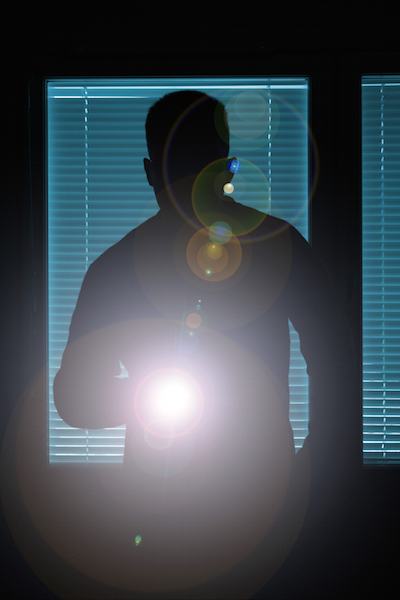 We’ve all experienced those moments of blinking disorientation when a bright light has been shone directly into our eyes. You’re seeing spots and not much else. And depending on the brightness of the light you might even feel dizzy or in pain.
We’ve all experienced those moments of blinking disorientation when a bright light has been shone directly into our eyes. You’re seeing spots and not much else. And depending on the brightness of the light you might even feel dizzy or in pain.
That’s what we aiming for when trying to disorient an attacker – to get that fleeting period when they’re confused by the bright light so that we can escape.
It’s important to point out here that we’re not thinking of the flashlight as an offensive weapon, and there’s a law of diminishing returns – the more you use the light in this situation, the less effective it becomes. The idea is to use a quick burst of light directly into your attacker’s eyes, and then TURN IT OFF AND ESCAPE.
When you leave your flashlight on too long, a couple of things happen. First, the assailant’s eyes will rapidly grow accustomed to the brightness. It may still be uncomfortable for them to look at it, but they’ll lose that disorientation and pain that we’re aiming for. Second, the light identifies where you are, so you want to use it sparingly.
Ideally, you flick the light on for a second or two, switch it off, and move rapidly away. You’ll have better night vision than your attacker, so make the most of it. If he follows you and is getting close, you can try the trick again.
The final way to disorient an attacker is to confuse them as to where you are. In darkness, hold the flashlight at arm’s length before you switch it on. The attacker will now think you’re where the light is coming from and will attack (or shoot!) there instead of directly at you.
In semi-darkness, hold the light close to you as you switch it on and shine it in your attacker’s eyes. Then, keeping the flashlight in the same place, MOVE YOUR BODY out of the way. To the attacker, it won’t be obvious that you’ve moved. They’ll see you turn on the flashlight, but they won’t see you move away. Again, this can give you a precious advantage if they attack the spot where you’re no longer standing.
An improvised weapon
Again, we recommend discretion as the better part of valor here. If you have the option to escape, take it. However, sometimes conflict can’t be avoided, and in those situations the right type of flashlight is a formidable advantage.
Lights marketed as tactical flashlights generally share a few characteristics. They’re easily pocketable, made of a strong material such as weapons-grade aluminum, and have a ‘strike bezel’. This bezel around the lens has a series of ridges and is intended to be used to strike an assailant – hence the name.
The idea behind the strike bezel is that by reducing the area that makes contact during impact, you increase the amount of force in the parts that do actually hit.

It’s even possible to buy after-market strike bezels to give your flashlight an upgraded offensive capability – and there are some truly mean and effective replacement bezels out there. Going down this route is a bit of a statement, however. You’re turning your defensive flashlight into an offensive weapon, essentially. And it’s almost certain to be confiscated by the TSA if you try to take it through airport security.
It has to be remembered that lack of weight is generally considered a benefit for flashlights, so the strike bezel lets you make the best use of the small amount of heft that a tactical flashlight can give you.
The main point to note is that you should really be striking with the very end of the flashlight. Imagine the flashlight as a light saber – you want to stab the light into your attacker, not use a slicing motion. You get the best benefit from the strike bezel if you’re literally trying to hit someone with the lens of the flashlight. Striking down at any other angle is going to be much less effective.
If one blow is enough to disable your attacker, run away. Once more, discretion is the key here. Self defense is about surviving to live another day, not putting your attacker in the hospital. Having said that, only you’ll be able to judge the exact situation – it’s up to you to determine how much force you need to use. But your primary motivation should be to get yourself out of harm’s way as quickly as possible.
What makes a good tactical flashlight?
For us, these are the most important considerations. Bear in mind that we’re talking more about EDC (everyday carry) tactical flashlights than ones that are weapon-mounted.
Small. Size does matter, but here it’s the reverse of the usual formula! You want something that’s small enough and light enough that you’ll have it with you wherever you go. Yes, a heavier flashlight might make a better improvised weapon, but that’s no comfort if it’s sitting at home in your drawer because you couldn’t handle the weight of carrying it around with you.
At least 100 lumens of light output – and preferably more. The brighter the light, the more effective it will be at disorienting an attacker and spoiling their night vision. Err on the side of caution here. If it costs a few dollars more to get a brighter light, spend the money.
Easy to use. You want a light with a simple button or switch that comes on at its brightest setting. Simplicity is the key. You won’t have time to be messing around with different modes or trying to remember how many button presses get you from moonlight to turbo. Instant full-on is what you want. Having said that, yes, modes like strobe or SOS can come in useful. But if you go down this route, make sure that you fully understand how the flashlight works and if there’s an option to leave max power as the default mode, do so.
LED bulb. This is really a no-brainer. The last thing you want with a tactical flashlight is to have the bulb break in an emergency because you’ve dropped it or hit it against an attacker. LEDs are MUCH more resilient than incandescent bulbs, so yourself a favor and don’t consider anything else.
Waterproof. This is an emergency situation you’re talking about, right? You don’t know what the circumstances will be. It could be raining heavily, you could drop your light in a puddle. This flashlight can only help save your life if it’s still working, so go for a waterproof one if possible.
Tough. This again almost goes without saying. You want a strong flashlight made from durable materials that can stand up to some punishment. Nowadays, that’s probably going to mean anodized aluminum, which is perfect for this kind of application.
Comfortable. If possible, try the flashlight out in person. You need to be happy that it fits your grip properly, and that you’re not going to be fumbling to use it. Similarly, check that you like the positioning of the button or switch.
Get a FREE tactical flashlight
Our friends at SurvivalLife.com are currently giving away a free $25 Hybeam Tactical Flashlight – you just have to pay for shipping. The other good news is that it also comes with a free Ultimate Survival Skills book and a two-hour Survival Course.
Our recommended tactical flashlights
Fenix PD35
At an eye-watering 960 lumens max power output, the PD35 provides a stunning amount of illumination in a compact package.
Five modes will run from just one hour 10 minutes in turbo mode, right through to 150 hours in the economy mode (14 lumens). There’s also a strobe mode, which operates at the maximum 960 lumens.
Digitally-regulated output means the flashlight maintains constant brightness, and a low-voltage warning reminds you when it’s time to replace the batteries, which can be either one 18650 rechargeable or two CR123As.
At 5.5 inches long and three ounces without batteries, the PD35 is, for now, our must-buy tactical flashlight.
Amazon buyer rating: 4.9 out of 5.
Olight M18 Maverick
The M18 Maverick ticks all the boxes in terms of being small, light, and very, very tough. And with 500 lumens, it’s got plenty of power too.
The stainless steel crenelated bezel not only looks extremely cool but would be very practical in close-up combat.
The M18 has a tail switch to turn the unit on and off, with a side switch to change the output level. This is memorized on turn-off, so the flashlight will come back on to the same power level – a very nice touch. It also has SOS and strobe modes.
It’s powered by two CR123A batteries, or one 18650 rechargeable, and comes with a glow-in-the-dark ring under the bezel in case you drop it in the dark.
At a shade over two ounces (without batteries) and just five inches long, the M18 is small enough and light enough to go everywhere with you. And tough enough to do whatever you ask of it.
Amazon buyer rating: 4.3 out of 5.
Streamlight 88031 ProTac 2L
At ‘only’ 260 lumens, the output of the ProTac 2L doesn’t match up to the M18, but the build quality and reputation of Streamlight makes up for that for many users.
The company manufactured its ProTac line with the needs of law enforcement officers in mind, resulting in a range that’s highly-regarded and highly-adaptable. For example, the unit is programmable to allow the switch to select one of three different programs.
The ProTac 2L is powered by two CR123A batteries, which provide a run-time of three hours on high mode and 50 hours on low power (13 lumens). There’s also a strobe mode which can run for six hours.
Weighing 2.8 ounces with batteries, and having a length of 4.8 inches, the 2L is made from anodized aluminum and is rated IPX7 for waterproof operation at one meter for 30 minutes. It’s also tested for two-meter impact resistance and had an unbreakable pocket clip and an anti-roll head.
Amazon buyer rating: 4.6 out of 5.

